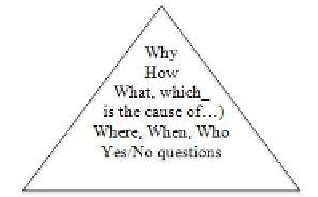Information Technology Reference
In-Depth Information
Aristotle pointed out that efficient causes are “the primary source of change”.
The transmission of such changes in a causal network is a mechanism. In this pa-
per we deal with the analysis of
what
-,
how
-and
why
-questions focusing not only
on efficient or final causes, but also on the crisp or imperfect mechanisms group-
ing them; i. e., - in terminology of K. Sadegh-Zadeh -, focusing our attention in
fuzzy causal spaces [9], causal systems that label the link between causes and effect
not using crisp numbers, but vague percentages (about 80%) or vague intensifiers
(
moderately
,
strongly
and so on) [10]. The following pyramid arranges interrogative
particles depending on the potential complexity of their answers [13]:
Fig. 17.1
Pyramid of questions' complexity
Ascending in the pyramid means demanding more and more complex answers
instead of
yes
,
no
replies, stimulating reflective and deepest thinking. At the top,
why-questions ask for some kind of explanation.
This paper will approach how to reach answers to causal questions: (1) what-
questions as identifying the cause of a mechanism; (2) how-questions as select-
ing appropriate parts of a mechanism and (3) why-questions as extracting the prior
cause, the final effect (contained in the posed question) and the information labeling
relevant nodes.
Thus, this paper is organized as follows: in section 2 we analyze the mechanism
to provide an answer to what-questions. In section 3 we will focus on the answer to
how-questions. In section 4 why-questions will be approached. Finally, a section of
conclusions and references close this work.
17.2
Answering What-Questions
In [8], Puente, Sobrino, Olivas & Merlo described a procedure to automatically
display a causal graph from medical knowledge included in several medical texts.
Sentences from medical texts frequently show causality as imperfect or approx-
imate in nature. This feature comes from the linguistic hedges or fuzzy quanti-
fiers included in these sentences. A Flex and C program was designed to analyze
causal phrases denoted by words like 'cause', 'effect' or their synonyms, highlight-
ing vague words that qualify the causal nodes or the links between them. Another
C program receives as input a set of tags from the previous parser and generates a




